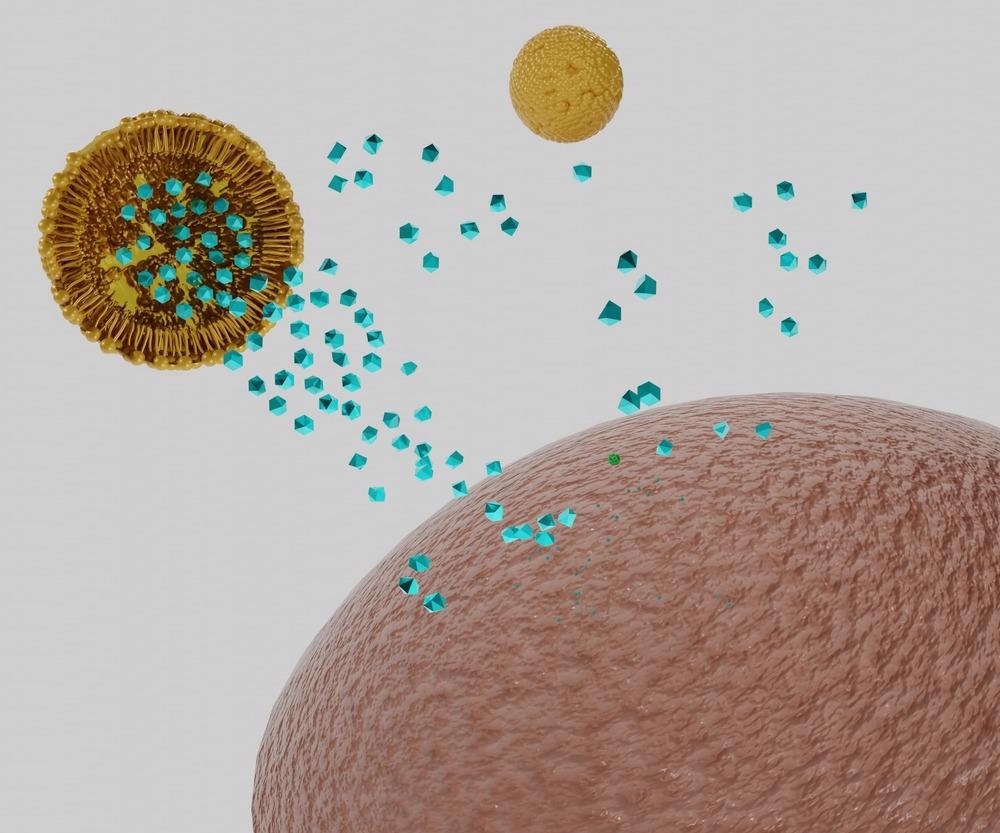In a recent study published in the journal Carbohydrate Polymers, researchers from China developed a novel mucoadhesive drug carrier based on thiolated carboxymethyl chitosan /mannose-anchored quaternized chitosan composite nanoparticles (NPs).

Study: Mannose-anchored quaternized chitosan/thiolated carboxymethyl chitosan composite NPs as mucoadhesive carrier for drug delivery. Image Credit: Love Employee/Shutterstock.com
Effective targeted delivery of drugs to specific organs, tissue, or cells is crucial in the pharmaceutical industry, making drug carriers as important as the drug itself.
Moreover, the synthesis of suitable drug carriers is highly essential for sustained release and prolonged stability of drugs.
The synthesized NPs exhibited high hydrophilicity, sustained drug release, bio-stability, biocompatibility, enhanced mucosal adhesion, and effective macrophage loading.
Mucoadhesive Drug Carriers
The mucus layer is an ultrathin protective layer covering the lining of epithelial tissues of most organs.
Mucoadhesive NP drug carriers adhere to the surface of a specific organ and facilitate sustained release of a high quantity of drugs or macrophages.
Moreover, anionic polymers and chitosan-based NP carriers have shown promising drug-carrying potential owing to their small particle size, non-toxicity, high zeta potential, enhanced receptor binding, and hydrophobicity.
However, chitosan has very poor solubility in alkaline and neutral polar solvents, limiting its practical applications.
As a solution, carboxymethylated polysaccharide modification of synthetic chitosan has demonstrated improved water solubility, thermal stability, and enhanced bioactivities.
The adhesion of modified chitosan to the mucus layer can be improved by restricting the movement of sulfhydryl groups on the chitosan by forming disulfide bonds between sulfhydryl groups cysteine-containing glycoproteins in the mucus layer.
N-acetyl-L-cysteine (NAC) is a less toxic, more water-soluble, and less oxidizable alternative to cysteine for improving mucosal adhesion.
About the Study
In this study, D-mannose was first bonded with N-2-Hydroxypropyl trimethyl ammonium chloride chitosan (N-2-HACC) using sodium triacetoxyborohydride [NaBH(OAc)] as the reductive amination reagent to synthesize mannose-conjugated N-2-HACC (M-N-2-HACC).
Meanwhile, NAC was coupled to the carboxymethyl chitosan (CMCS) to form thiolated CMCS. Finally, M-N-2-HACC/N-CMCS NPs were formed via the electrostatic interaction of negatively charged thiolated CMCS and positively charged M-N-2-HACC.
Subsequently, the particle size, zeta potential, encapsulation efficiency, loading capacity, stability, in vitro sustained release, cytotoxicity, and mucosal adhesion effectiveness of the prepared M-N-2-HACC/N-CMCS NPs was measured.
Observations
The reaction yield of prepared M-N-2-HACC and N-CMCS odorless fibrous powder was 55.5 ± 4.76 wt% and 62.48 ± 7.73 wt%, respectively. Additionally, both of them were highly soluble and transparent in the water. Similarly, the zeta potential of both was 25.44 ± 0.60 mV and -3.79 ± 0.40 mV, respectively.
The derivative thermogravimetric (DTG) results showed that the maximum pyrolysis temperature was 210.62° C, 214.73° C, 243.45° C, and 281.41° C for N-2-HACC, CMCS, M-N-2-HACC, and N-CMCS, respectively.
Also, the presence of D-mannose weakened the intermolecular conformation of N-2-HACC into an amorphous structure, which was compensated by sulfhydryl-modified CMCS.
The mucus layer contains a large number of hydrophobic segments thus, hydrophilic functional groups such as the carboxylic group enhanced the mucosal adhesion.
The contact angles of M-N-2-HACC and N-CMCS were 28.3° and 34.5°, respectively, evidencing hydrophilicity. Similarly, the encapsulation efficiency and drug loading capacity was 45.21 ± 0.81%:23.42 ± 0.55%. and 5.32 ± 1.52%:37.83 ± 2.37% for M-N-2-HACC and N-CMCS, respectively.
Furthermore, M-N-2-HACC/BSA/N-CMCS NPs exhibited a very high cell survival rate of above 90% against 293T cells at the concentration of 31.25 and 62.5 μg/mL.
The mucosal adhesion effect of NPs indicated that the mucin III adsorption at the concentrations of 2.0 mg/mL and 1.0 mg/mL was due to the electrostatic interaction between negatively charged mucin III and positively charged N-2-HACC/CMCS NPs.
Conclusions
In summary, the researchers synthesized hydrophilic carboxymethylated polysaccharide modified synthetic chitosan, M-N-2-HACC/BSA/N-CMCS NPs, for improved adhesion to mucus layer of organ, thus enhancing targeted delivery of drugs and macrophages.
The prepared mucoadhesive drug carrier demonstrated improved hydrophilicity, thermal stability, reaction yields, encapsulation efficiency, drug loading capacity, and adhesion to mucus layer due to electrostatic interaction between the carrier and cysteine.
Hence, M-N-2-HACC/BSA/N-CMCS NPs are a promising candidate for mucoadhesion-based targeted drug delivery.
Continue reading: Natural Rubber Nanocomposites: a New Path for Prosthetics
Reference
Jin, Z., Hu, G., Zhao, K., (2021) Mannose-anchored quaternized chitosan/thiolated carboxymethyl chitosan composite NPs as a mucoadhesive carrier for drug delivery, Carbohydrate Polymers. Available at: https://www.sciencedirect.com/science/article/pii/S0144861722000789.
Disclaimer: The views expressed here are those of the author expressed in their private capacity and do not necessarily represent the views of AZoM.com Limited T/A AZoNetwork the owner and operator of this website. This disclaimer forms part of the Terms and conditions of use of this website.